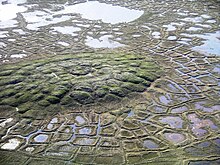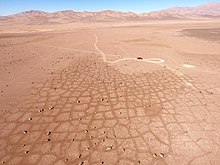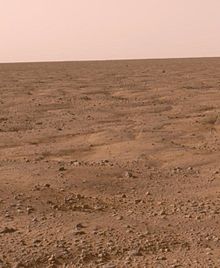Patterned ground


Patterned ground is the distinct and often symmetrical
Types
Patterned ground can be found in a variety of forms. Typically, the type of patterned ground in a given area is related to the prevalence of larger stones in local soils and the frequency of freeze-thaw cycles.[4][5][6][7][8][9]

Polygons
Polygons can form either in permafrost areas (as ice wedges) or in areas that are affected by seasonal frost. The rocks that make up these raised stone rings typically decrease in size with depth.[6][11]
In the northern reaches of the
Circles
Circles range in size from a few centimeters to several meters in diameter. Circles can consist of both sorted and unsorted material, and generally occur with fine sediments in the center surrounded by a circle of larger stones. Unsorted circles are similar, but rather than being surrounded by a circle of larger stones, they are bounded by a circular margin of vegetation.[13][6]
Steps
Steps can be developed from circles and polygons. This form of patterned ground is generally a terrace-like feature that has a border of either larger stones or vegetation on the downslope side, and can consist of either sorted or unsorted material.[4][6]
Stripes

Stripes are lines of stones, vegetation, and/or soil that typically form from transitioning steps on slopes at angles between 2° and 7°. Stripes can consist of either sorted or unsorted material. Sorted stripes are lines of larger stones separated by areas of smaller stones, fine sediment, or vegetation. Unsorted stripes typically consist of lines of vegetation or soil that are separated by bare ground.[15][16][6]
It has been conjectured that periglacial stripes on Salisbury Plain in England, that happened by chance to align with the solar sunrise at mid summer and sun set at mid winter , gave rise to awe and veneration by prehistoric people that eventually culminated in the building of the Stonehenge.[17]
Formation

In
Patterned ground occurs in alpine areas with freeze thaw cycles. For example, on
Frost also sorts the sediments in the ground. Once the mantle has been weathered, finer particles tend to migrate away from the freezing front, and larger particles migrate through the action of gravity. Patterned ground forms mostly within the active layer of permafrost.[18][21]
See also
References
- ^ S2CID 129324724.
- ISSN 0169-555X.
- ^ "Southern Hemisphere Polygonal Patterned Ground". Mars Global Surveyor: Mars Orbiter Camera. Malin Space Science Systems. Archived from the original on 27 October 2016. Retrieved 8 November 2013.
- ^ a b "Patterned Ground". Archived from the original on 29 March 2017. Retrieved 21 September 2016.
- ^ Ballantyne, C.K. (1986). "Non-sorted patterned ground on mountains in the Northern Highlands of Scotland". Biuletyn Peryglacjalny. 30: 15–34.
- ^ ISBN 978-0-19-107895-8.
- ^ Ólafur, Ingólfsson (2006). "Glacial Geology Photos". Retrieved March 4, 2007.
- S2CID 27238820.)
{{cite journal}}: CS1 maint: multiple names: authors list (link - .
- ISSN 0169-555X.
- ISSN 0016-7398.
- ^ C. Michael Hogan. 2008. Black Spruce: Picea mariana, GlobalTwitcher.com, ed. N. Stromberg Archived 2011-10-05 at the Wayback Machine
- PMID 24191111.
- ^ Davies, Bethan. "stone stripes". AntarcticGlaciers.org. Retrieved 2022-03-24.
- .
- S2CID 128558678.
- ^ Yirka, Bob; Phys.org. "New dig suggests Stonehenge was built to align with summer and winter solstice". phys.org. Retrieved 2022-03-24.
- ^ ISBN 978-0-13-860958-0.
- ^ Baker, B. H. (1967). Geology of the Mount Kenya area; degree sheet 44 N.W. quarter (with coloured map). Nairobi: Geological Survey of Kenya.
- ISBN 978-9966985606.
- JSTOR 4014632.
External links
 Media related to Patterned ground at Wikimedia Commons
Media related to Patterned ground at Wikimedia Commons
